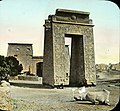Gate construction
Gate buildings or gate structures , more rarely gate halls , are larger, largely independent and deeply designed gate systems in the sense of an independent building (sometimes with its own premises) or a functional unit as part of a larger building or building complex. They usually stand on the border between two uncovered open spaces (courtyard, street), have an upper connection ( arch , architrave ) and often have less of a functional but more of a representative character.
Examples
The gate structures include gates of honor such as triumphal arches , triumphal gates , but also bridge gates ; also the Indian toranas and gopurams as well as the Japanese torii and Chinese false gates ( pailou ) belong to it.
In Egypt there is the pylon as a gate and in Greece the propylon with numerous special forms.
City gates , castle and monastery gates (often in the form of gatehouses ) are part of a fortification; many of them have tall dominant towers.
The interior of a gate (in the case of a triumphal arch, the open area under the arch) is often called the gate hall . The mortuary temple at Saqqara or the Gate of Xerxes in Persepolis have remarkably large gateways.
- Egypt, Mesopotamia, Persia
Gate of the Karnak Temple
Gate of the Nations, Persepolis
- Greece and Rome
Tetrapylon of Cáparra
- middle Ages
Ezelpoort, Bruges
- Modern times
Triumphal gate of the parish of Saint-Thégonnec
- India
Gopuram of Minakshi Temple , Madurai
Gate of the Radha Madhap Temple, Bishnupur
- Islam
Gate of the Amir Chaghmaq Mosque, Yazd
Gateway to the Humayun Mausoleum , Delhi
Gate construction of the Akbar mausoleum , near Agra
- Maya


































